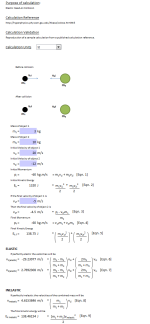Elastic Collision

Description
Purpose of calculation:
Elastic Head-on Collision
Calculation Reference
http://hyperphysics.phy-astr.gsu.edu/hbase/colsta.html#c5
Calculation Validation
Reproduction of a sample calculation from a published calculation reference.
Calculation Reference
Impact Calculations
Dynamics
Elastic Collision
In an elastic collision, both momentum and kinetic energy are conserved. Elastic collisions occur when two objects collide and then separate without any permanent deformation or energy loss through heat or sound. To calculate the final velocities of two objects after an elastic collision, you can follow these steps:
-
Identify the initial conditions: Determine the mass (m1 and m2) and initial velocities (v1_initial and v2_initial) of the two objects involved in the collision.
-
Conserve momentum: The total momentum before the collision is equal to the total momentum after the collision. Write the conservation of momentum equation:
m1 * v1_initial + m2 * v2_initial = m1 * v1_final + m2 * v2_final
- Conserve kinetic energy: The total kinetic energy before the collision is equal to the total kinetic energy after the collision. Write the conservation of kinetic energy equation:
0.5 * m1 * v1_initial^2 + 0.5 * m2 * v2_initial^2 = 0.5 * m1 * v1_final^2 + 0.5 * m2 * v2_final^2
- Solve the equations: Solve the system of equations consisting of the conservation of momentum and conservation of kinetic energy equations to find the final velocities (v1_final and v2_final) of the two objects after the collision.
For a one-dimensional elastic collision, the equations can be simplified and solved directly:
v1_final = ((m1 - m2) / (m1 + m2)) * v1_initial + ((2 * m2) / (m1 + m2)) * v2_initial
v2_final = ((2 * m1) / (m1 + m2)) * v1_initial + ((m2 - m1) / (m1 + m2)) * v2_initial
By calculating the final velocities after an elastic collision, you can analyze the behavior of objects in various applications, such as billiard balls, gas particles, or vehicles in traffic simulations. Keep in mind that these equations assume a perfectly elastic collision, and in reality, some energy may be lost due to deformation, heat, or sound. In those cases, the collision would be considered inelastic, and the conservation of kinetic energy equation would not be applicable.
Calculation Preview
Full download access to any calculation is available to users with a paid or awarded subscription (XLC Pro).
Subscriptions are free to contributors to the site, alternatively they can be purchased.
Click here for information on subscriptions.


